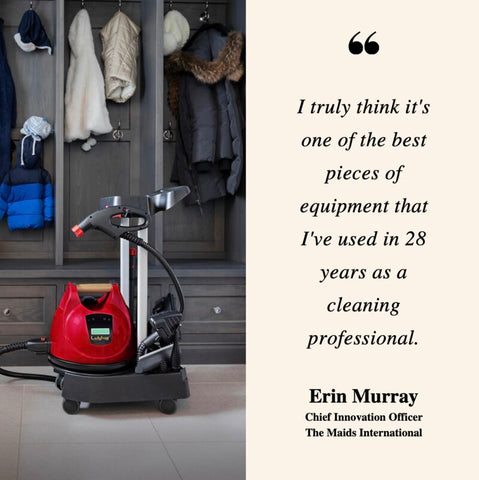Cleaning and Disinfecting Without Chemicals: Why It’s Important and How To Do It
The pandemic has people spraying, scrubbing and washing more than ever. So it’s no surprise that the use of handy electrostatic sprayers loaded with disinfectants on the EPA’s List N is popular and embraced—especially by school custodians who are overworked and short-handed yet under pressure to make sure everything is disinfected daily to the smallest detail.
But experts say all that spraying may be having an unintended effect. We may be poisoning our children. That’s because all products—by law—on the EPA list of products to combat COVID-19 are pesticides. And pesticide exposure in childhood has been linked to attention and learning problems, as well as cancer. Even death.
It's no surprise, then, that parents are worried about the dangers of spraying classrooms, school hallways, and teachers’ lounges with EPA-registered chemicals. It’s pretty scary that poison control centers have urged caution as some say chemical cleaners are the “leading factor” behind poison control cases since Covid-19 was declared a global pandemic.

But don't worry…
Over the past few years, researchers specializing in the testing of antimicrobial agents at top U.S. laboratories such as Microchem and leading universities such as the University of Michigan undertook projects to test a non-toxic steam vapor cleaner against chemical disinfectants.
This was no ordinary steam vapor cleaner. It was one equipped with an innovative technology called Thermal Accelerated Nano Crystal Sanitation (TANCS®) that breaks down pathogens at a molecular level.
The purpose of the projects.
To understand the survivability of bacteria and viruses exposed to the combination of superhot dry steam vapor and TANCS®.
In peer-review format, the researchers found that a TANCS®-equipped steam vapor system disinfects thousands of times better than chemical disinfectants must meet to quality as EPA registered.
Please watch the following explainer video that describes how TANCS® uses the minerals found in ordinary tap water to destroy the outer cell membrane that protects bacteria and viruses so that superhot steam can reach and kill them.
Do all steam vapor cleaners have TANCS®?
No.
TANCS is proprietary to Advanced Vapor Technologies (Advap), developers of domestic steam vapor systems under its Ladybug® brand, and commercial systems under its MondoVap® and VaporJet® brands.
How do you use a steam vapor cleaner?
Advap engineers made sure cleaning and disinfecting most things is as easy as a simple pass over a surface. That’s it. No elbow grease is required. Superhot steam and TANCS® work in concert to seamlessly clean and disinfect—all in one step. Only, unlike chemical cleaners, which leave behind a residue that breeds new microbial growth, TANCS® leaves nothing behind.
From cleaning and disinfecting surfaces in restaurants, hotels, schools, and healthcare settings to home bathroom, kitchen, and pet area cleaning, Advap steam vapor systems are exceedingly capable. The Ladybug® 2350 is the tool of choice for pros like national franchise The Maids International, and the MondoVap® 2400 is used by numerous hospitals, restaurants and hotels, and over two-thirds of VA medical centers.

Click here to check out the MondoVap® training video from Kerry Rigg, an instructor for the Occupational Safety and Health Administration (OSHA), a regulatory agency created by Congress to ensure safe and healthful working conditions. Mr. Rigg has trained over 6,000 custodians during his career.
Can't I just use vinegar to kill bacteria and viruses?
No. Contrary to popular belief, vinegar just kills a few things and doesn't do it efficiently. And you need to allow vinegar at least 30 minutes of contact time. The large collection of peer-reviewed studies mentioned above confirm that Advap steam vapor systems kill a very broad range of bacteria and viruses like MRSA, C. diff, norovirus, C. parvo, and coronavirus 229E, the EPA recommended surrogate for testing the efficacy of products used to combat COVID-19, in 7 seconds or less.
How about Hydrogen Peroxide?
Again, no. Products containing Hydrogen Peroxide also require a lengthy dwell time. Plus Hydrogen Peroxide has bleaching properties that lighten surfaces. It also contributes to illness if touched, ingested, or inhaled.
What about the green cleaners that line supermarket shelves?
The problem with the term “green cleaning” is that terms like green, eco-friendly, organic, and natural are marketing terms with no legal definition. That means it’s hard to know what’s lurking in these products. Despite colorful labels with pictures of green fields and yellow flowers, most green cleaning products—with the exception of a few such as our favorite, plant-based Branch Basics—are in fact chemical cocktails. It’s a bit of a surprise, but it’s true because there is no federal regulation.
What does the EPA say about TANCS®?
While federal law dictates that only pesticides are approved for EPA registration, the EPA oversees the regulation of devices so that they do not make “false or misleading” claims. An Establishment Number is assigned only to those that meet the EPA’s toughest requirements.
In the case of Advap, the large collection of peer-reviewed studies validate that steam vapor systems equipped with TANCS® disinfect faster and better than most chemical disinfectants. The studies are published in top scientific journals such as the American Journal of Infection Control.
As a result of these studies, the number EPA Est. No. 82121-WA-01 is assigned to Advap and is proudly displayed on each Ladybug®, MondoVap®, and VaporJet® steam vapor system the company offers for sale. The number tells you in a glance that your device qualifies as a disinfection device for the EPA.
Only Advap has TANCS®. Don’t be fooled by knockoffs and lookalikes with improper claims of disinfection.



